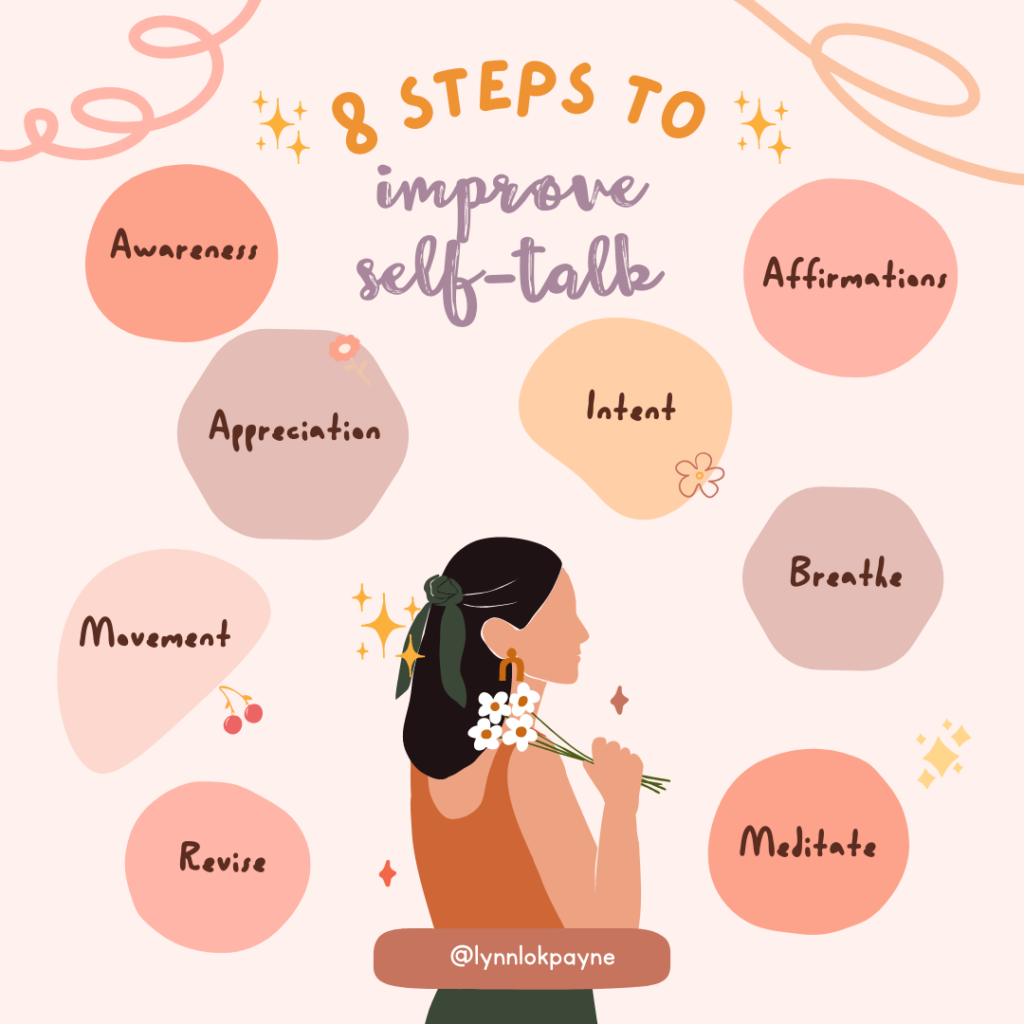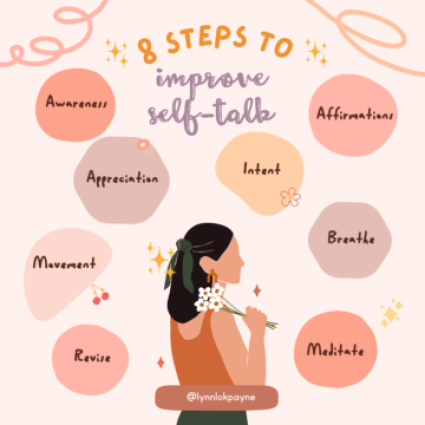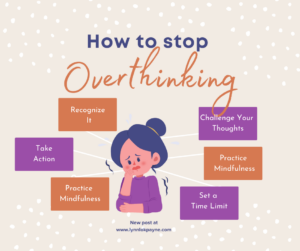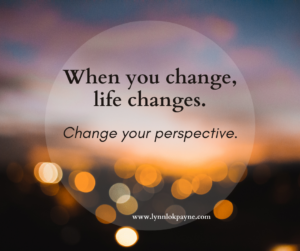
Our inner dialogue affects our lives in either a good way or not so good way. How we think creates our actions, which become our reality. We can improve negative self-talk.
Unfortunately, our minds are hard-wired to focus on the negative. This comes from earlier times when we had to avoid life-and-death threats, such as being attacked by an animal. This fight-or-flight mode was very useful back then.
But today, most of our stresses and negative thoughts are not life threatening. We worry about stuff that never happens. How many times is our mind playing a negative loop? We say I can’t; I am not good enough; my life won’t change… By becoming mindful of our thoughts and change our dialogue to something more positive, or at least neutral, then the outcome will be different.
We can purposely guide our thoughts to move from worst-case scenarios to something more empowering. Here are eight easy steps to improve negative self-talk and move you towards a more uplifting path.
1. Awareness
Be aware of the mental chatter. What are you telling yourself? Is this thought, belief, or story really true? If not, delete or revise it. Our minds act out of habit and return to prior responses. With conscious awareness, we can change our direction.
Cognitive neuroscientists have discovered that only about five percent of our cognitive activity is conscious. This means that 95 percent of the time, we are not mindful of our behavior, actions, decisions, and emotions. Paying attention to our mental conversations helps us to reevaluate and shift our thinking.
“The brain can be trained to improve one’s focus and attention and also to not respond to the ongoing dialogue in our head that distracts us from making clear and useful decisions,” states James M. Doty, MD, Neurosurgeon.
2. Affirmations
Create positive affirmations and repeat them daily. This develops new neural pathways in our brain, and in time, we will start to accept and believe in these new thoughts.
Many thoughts are just habits. By revising our thoughts, we can form new neural pathways that will generate different behaviors. Change the response and the result changes.
3. Revise Inner Dialogue
Reframe negative self-talk to something more constructive. Instead of thinking, I can’t do it, revise your talk to something more empowering, like, It may take time, but I can get there. Revising our internal dialogue opens the possibilities door.
And feel positive aspects of a situation, such as my job is only ten minutes from my house or it pays the rent. This helps to switch our emotions. Sometimes all it takes is discovering little reasons to be grateful to move negative thinking to a more positive or neutral emotional state. The more we focus on appreciation, the more appreciation we find.
“If you change the way you look at things, the things you look at change.” — Dr. Wayne Dyer, American philosopher, author, inspirational speaker
4. Appreciation
When we focus on the good, appreciation and gratitude naturally follow. I believe gratitude is the key to living a happy life. When we appreciate what we already have, we find joy and peace.
To focus on the good, create a gratitude list or gratitude journal. It doesn’t have to be anything big. Write simple things, such as, The sun came out today and made me smile. Finding gratitude in little things helps us appreciate life much more.
If you have a bad day, revise to What am I grateful for? Or What has worked today? Count your blessings and make gratitude a practice. When we do, ordinary events become extraordinary!
5. Breathe
When we get stressed, we breathe more shallow, and this can increase our anxiety. Notice if you are breathing deeply or shallowly. Put one hand on the chest and the other on the belly. Take a few breaths. Did your belly or chest rise? This tells you if you are breathing from the diaphragm (deeper breaths) or from the chest (more shallow breaths).
When you breathe through your diaphragm instead of your chest, you get more oxygen into the lungs and this can lessen stress, lower blood pressure, and slow heart rate. When I put my awareness on my breath and breathe from the belly, I lessen my negative self-talk, become more peaceful, and increase my attention and energy levels. What’s good for the body is also good for the mind.
6. Meditate
Meditation has many health benefits. It improves concentration and sleep, increases happiness, lessens anxiety and stress, and increases the production of anti-aging hormones, just to name a few. There is nothing fancy or mysterious here. All you need to do is to be still.
If this is hard for you, start with a just one minute and slowly increase it until you can be still for about fifteen minutes. You can concentrate on your breath or use a guided meditation. Your eyes can be open or closed. You can sit or lie down. Do whatever is comfortable for you.
It’s more beneficial to meditate for one minute a day than seven minutes once a week. Create a practice that works for you. The goal is just to quiet the mind. You will always have thoughts creep in. It’s just not to let them bother you.
When our minds and bodies are more tranquil, we function better and it is easier to find positive emotions, such as gratitude and happiness.
7. Movement
Meditation can also be in the form of movement, such as yoga or walking. Any movement that moves you out of your head and helps you to relax, such as painting, dancing, or gardening, can be meditation. When we are in a tranquil state, we can tap into a flow of ideas and creativity.
I even have a MediTEAtion practice where I slowly sip tea and savor it as I look at nature. This helps me to unwind and get into the present moment. And looking at nature always puts me in a state of gratitude.
8. Intent
Use your time wisely. Before you do something, ask yourself if this act is intentional? Or are you doing it to avoid doing something else? I know it’s easy to get distracted and jump to the “new shiny thing” versus doing what’s important. I can get pulled down the informational rabbit hole and unintentionally waste time. Be mindful and focus on what’s important first instead of avoiding what needs to be done.
And decrease the time you give to negative influences, such as news or some social media accounts. If something doesn’t make you feel better, why spend a lot of time with it? According to research from Harvard, three minutes of negative news makes viewers 27% more likely to have report having a bad day, even up to eight hours later. But people who watched transformative stories reported having a good day 88% of the time.
Flip the Script
With the above practices, you will notice less negative self-talk. Our bodies and mind act out of habit. They go back to where they have gone before. So train them to go to a different place. A place where there is more happiness, less stress, and more peace. And then you will see more opportunities and possibilities than you ever could imagine.
What we conceive and desire, we can create. Attention is key!
Once I learned to change my internal script and direct my attention to the good things in my life, instead of what was not working, my life changed for the better. We can cultivate the mind to see the positive. The question is, what are we attracting?
Positive thoughts and emotions have power and can influence life profoundly. Flip the script and change your negative self-talk. Be the magnet for what you want to appear in your life. You are the solution.
And maybe that’s just what Glinda in The Wizard of Oz was trying to tell Dorothy, “You’ve always had the power, my dear, you just had to learn it for yourself.”

Need more: Read this blog!
Want more information on breathing? Listen to Deepak Chopra’s Assessing Your Breath Rate. https://bit.ly/Deepaksbreathtechnique





